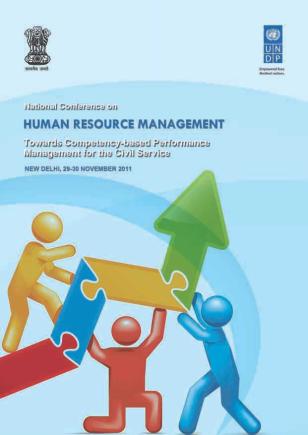National Conference on Human Resource Management - towards Competency-Based Performance Management for the Civil Service

National Conference on Human Resource Management - towards Competency-Based Performance Management for the Civil Service
February 20, 2013
The Department of Personnel and Training (DoPT) / Ministry of Personnel, Public Grievances and Pensions (MoP) and the United Nations Development Programme (UNDP) organized a National Conference on Human Resource Management: Towards competency-based performance management for the Civil Service. The conference was held in New Delhi under the auspices of the DoPT-UNDP Pathways for an Inclusive Indian Administration (PIIA) Project.
Since, examples of competency-based Human Resource Management in Civil Service are few and relatively recent, it was necessary to know of experiences and lessons learnt in the private and public sectors where the concept has been applied in practice. In addition, it was important to gain knowledge from academicians, experts and practitioners across sectors. The conference therefore brought together a broad spectrum of practitioners with demonstrated leadership in the HRM field from reputable institutions in India and abroad. The international speakers presented how their respective Governments addressed HRM using competency frameworks, highlighting lessons-learnt, innovations and practical solutions. The conference objectives were to gain understanding of:
The concept of a competency-based approach to HRM for the Civil Service, its advantages and disadvantages based on international and Indian experiences;
Policy challenges encountered by government and the private sector in applying a competency-based approach to HRM;
Methodologies, including implementation arrangements, which have proven to yield results;
Systemic changes that would be required to implement competency-based HRM in the Indian Civil Service.
The conference agenda was a mix of plenary sessions that lay the foundation of discussing current bottlenecks, endeavours of reform, and possible solutions in more depth. The discussions, findings and recommendations of the working groups were presented in the closing session of the conference. The event was attended by officials dealing with Human Resource Management (HRM) functions in the Central Government and State Governments (General Administration Departments, Administrative Training Institutes), and representatives from the Cadre Controlling Authorities for various Central and All India Services. This report outlines the main findings of the workshop.
Some take-aways from the Conference:
- Consider the overall initiative as a mega-project with a broad architecture that is an anchor for pilots and State-level initiatives. Initiate pilots that contribute to developing links with the overall initiative. Start with four to five pilots covering about twenty Departments/ Divisions/ agencies to identify and arrive at a consensus on 40 to 50 competencies.
- Need for clarifying the concepts and objectives of using the competency framework and for articulating the vision and purpose clearly upfront. This will not only help bring clarity about the stated and unstated objectives, but also help in presenting them to the relevant stakeholders.
- Establish link with entities that have expressed interest and have already initiated changes in HRM. Explore option for taking a sample of about 20 Departments/ Divisions/ Divisions/ agencies to get a mix of success and problematic Departments.
- Establish link with the Performance Management Division, Cabinet Secretariat for short listing Departments/ autonomous bodies to pilot the initiative with as well as for strengthening the association and ‘hooking’ to RFD for enhancing support and acceptability for competency-based HRM.
- Form a dedicated team for introducing competencies based HRM for the civil services. Decide whether to hire the skills, build them internally (through learning initiatives), or outsource the work to others that already have the skills. If outsourced, it is important to ensure and the consultant is available and contracted for the whole cycle for continuity and cohesiveness. The appropriate option would be to develop internal capacity and have external guidance and handholding support during the introduction of competency-based HRM.
- An important step in the process of developing a competency framework is to prepare a template that can be used and which provides consistency in mapping competencies. This requires concerted efforts by a team comprising of experts and people familiar with the HR issues in the civil services.
- Conduct competency mapping in a way that the outputs are owned by the relevant decision-makers (civil service cadres, Ministries/ Departments/ Divisions, Stats etc.). One of the means for ensuring ownership is to involve cadre champions and seniors within and outside the Government, and to enable officers participate in the process of identifying ‘competencies’.
- Have a road map (5 to 6 years horizon) that connects the vision, purpose and objectives for introducing competency-based HRM with actions to be taken to achieve the short-term and long-term objectives. The process of developing the roadmap will help reach consensus about the vision and objectives, and will provide a framework for coordination and integration with the RBF.
- To get people on-board, strategize communication approach. Conduct activities and communicate through other means to raise awareness about the objectives, purpose and processes for introducing competencies based HRM. Highlight how it matches Government Vision (RBF), what Governments in other countries have done and achieved in addressing similar issues, and what progress is/ has been done. In addition, put across thought provoking questions that create the basis for continuing discussions and debates about competencies and the competency framework.
- Need for pragmatism and flexibility. The process for introducing competency-based HRM is likely to have a slow and patchy start but can have a rapid take up. It requires flexible language for thinking about work and performance and underpins agency capability planning and review.
- There is wide interest and external tailwind of support, especially from the private sector in Government actions for improving governance. This support can be utilized by the core team.
- Recognize and celebrate achievements no matter how small. This will provide opportunities for communicating with stakeholders, garnering support from champions as well as for lessening resistance.

 Locations
Locations